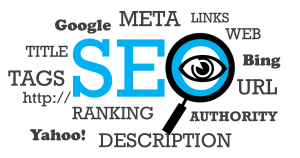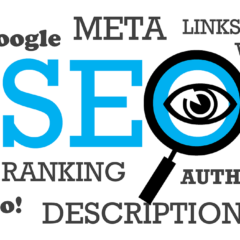Are There “Gaps” in Your Dental Website That Expose You to Failure?
The recent winter weather did some damage to our property. It’s not significant but some minor repairs are in order.
Timing isn’t always on your side when the weather is involved. But the timing is always right to evaluate your current dental website and close some of the gaps that make your marketing vulnerable to failure.
A gap is precisely what I have in my fence as result of the strong winter winds that blew through my region recently. As I early mentioned, the damage isn’t significant by comparison but my suburban property feels exposed now that I lost two sections of privacy fencing.
Close the gaps
I write a significant amount of webpage copy for dental practices, dental consultants, and dental industry businesses. There’s a gap these days between those that are riding the wave of content marketing strategy (one that I do not believe will go away anytime soon) and those that are either satisfied with their online (website) presence or assume that having one up-and-done is enough.
The gap is widening. If you’re on the side of the fence that values consistent, useful content published via a blog, newsletter, podcast, online course, ebooks, email series’, etc you’re positioned to take your “world” by storm.
On the other hand, if you’re resisting or uninformed about the value of content to stimulate your dental marketing, brace yourself for a storm of frustration. You could find yourself wondering why your dental website visitors arrive but don’t stay…or more important – don’t schedule.
It’s time to close the gaps. You shouldn’t feel exposed to frustration or worse waste your valuable dental marketing dollars over the next 12 months on a website that’s basically a digital brochure.
Exposing Your Dental Website “Gaps” and the Strategic “Repairs” You Can Make to Increase Your Value to Patients or Clients
Assess the “damage”
Your patients/clients visit your website for one, primary reason – to access information about your services. Their response hinges on what they discover in the first few seconds of arriving there.
“Gap”: Thinking it’s necessary to differentiate yourself with flashy web page banners or spotlighting your brand image/logo. You can damage your online influence if you’re solely relying on “creative, visual elements” to compel your site visitor to schedule or contract with you.
Damage assessment solution: Build credibility and potential for repeat site visits by providing simple, understandable answers to the questions your patients/clients are asking.
- Fill-the-gap with blog posts/articles published a minimum of two times per month, a downloadable podcast, a consistently published Q&A-like newsletter, or an easy to access and read ebook.
- Spend your available annual marketing dollars on those strategies that provide useful, valuable information your visitors are seeking.
Clear the “debris”
No doubt, dentistry is a technical industry. Healthcare relies on skilled expertise to diagnose and treat effectively.
“Gap”: Thinking it’s essential to thoroughly explain the technical details of your dental services, treatment, and procedures so your patients/clients will want to schedule/use your services. In essence, believing that the more they know, the more likely they are to view you as an expert and schedule.
There’s a better way…
Clean-up solution: Your authority/expertise is recognized more by your ability to speak your site visitors language. Leave the industry-speak to your communication with colleagues, at conventions, or your local study-club.
- Eliminate “jargon,” “fluff-content,” over explained services/procedures, high word count descriptions, and unnecessary credential data.
- Create a compelling connection with your site visitor through every-day language via conversationally written web page copy, blog posts, articles, newsletters, etc. (to keep the language conversational and every-day it’s a good idea for someone to write it other than you…no offense).
Restore the “solution”
Clarity rules. And simplicity shouldn’t imply poor quality or design.
“Gap”: Thinking that a graphically intense, creatively unique, high word count website will build trust with your audience.
Repair solution: Creative design, more words, and indulgent graphics can make your website more difficult to navigate, to understand, and unclear about what visitors should do next. Ditch the mindset that says, “(Our) website must compete on a creative level with every other dental industry site in our area/region….”
Your patients/clients will visit, stay, return, and schedule your services for one fundamental reason – you provide clear, compelling answers to their questions or solutions to their problems. Clarity and simplicity trump creative.
- Stand out creatively through informative and consistent content. Distribute your creative-vibe via your social media channels (Facebook page, Instagram, YouTube, etc.).
- Be an authoritative resource and you’ll compel trust…and action. And speaking of action – restore your web pages to include a clear call-to-action (e.g. “Contact us to schedule…,” “Click here for more information…,” etc.).
These simple repairs will close the “gaps” in your website and your digital marketing strategy. It’s best to create good exposure for your authority and expertise than to be exposed via ineffective web page content.
4 Strategies to Raise Your Dental Marketing Expectations for a Successful New Year
It wasn’t at all what he expected. And the outcome he experienced reminds me that setting your expectations accurately and appropriately can create new beginnings in your dental marketing.
Our grandson recently asked to “chase” his distasteful medicine with a “spoonful” of sugar. I agreed, casually grabbed a spoon from the drawer, dipped into the container, and delivered his request to a smiling face.
His reaction was priceless. He jumped up from the sofa, sputtering, spewing, and reported his distaste for what was served up saying, “That’s CREAMER!”
In my defense, I do not use sugar in my coffee. That said, I’m accustomed to only spooning a dash of creamer into my morning brew.
I instinctively reached for the creamer thinking it to be sugar. We laughed, as did our grandson after he cleansed his palate with the aforementioned requested sugar treat.
Meeting expectations
You should trust that you’ll receive what you expect. That’s often not the case.
Your audience comes to your dental practice or dental service business with a load of expectations. These days what’s expected has shifted a bit due to how information about your services is consumed.
And speaking of information…
Now’s a perfect time to review and hit refresh on informational content that can help you set your dental marketing expectation for the coming months. And being intentional with your expectations can improve your approach to those nagging New Year’s resolutions you feel compelled to make but fail to fulfill.
Consider this post a dental marketing reboot of some common themes from the past few months of posts.
How to Raise Your Dental Marketing Expectations and Experience a Compelling Amount of Success This Year
Renew your thinking about dental SEO
As I’ve written here before, I do not consider myself to be an SEO expert or specialist. I know enough to be “dangerous” in a sense.
And maybe that’s my point. Too much SEO thinking can blind you on your path to online success.
Here’s the deal (and this much I do know) – SEO isn’t about “gaming” or “baiting” your online presence. True SEO creates search expectations around the delivery of useful, informative, valuable content.
This is SEO, of course. But it’s not the SEO you’re perhaps conditioned to believe you must have on your website or else…
Think SEO but…think about it differently!
- Create content around solutions (answers) to the problems (questions) your online visitors are experiencing (asking).
- Make your website content savvy and the SEO will satisfy your online dental marketing expectations.
Check out more related insight here.
Revise your dental website
A website is only the beginning. It’s not a one-and-done dental marketing strategy.
Think of your website as a platform with access to multiple content channels. Those channels are where your dental “consumers” should be able to easily navigate information that (once again) provides solutions (answers) to their problems (questions).
- Lead with your blog/article page. Lose the mindset that you must have high word count, information-heavy, dental-speak fluff on your service/procedure pages (people read what informs them…not what you think they need to know about x, y, or z dental procedure – that’s your world…not theirs).
- Give your website visitors easy to access, readable, visual, audible content. Think blog, YouTube, and Podcast instead of a Wikipedia-like dental procedure glossary. Instead of a tired-does-anybody-read-it-anyway FAQ page chunk those frequently asked questions into compelling blog posts.
Check out more related insight here.
Re-purpose your content
Having a blog/article page that you consistently publish to gives you options. The more blog/article content you have the greater your ability to re-purpose the content.
Remember…
Some website visitors are readers. Some are visually oriented. Some are listeners.
- (For your “readers”) Re-purpose your written content (blog posts, articles, etc.) into e-books, a call-to-action email series, a newsletter, a tip-sheet, etc.
- (For your “viewers”) Re-purpose your written content into a YouTube video (a vlog), a Periscope, a Slide-Share, an Infographic, or other visual content like a GIF, Meme, etc you can post on your social media channels (Facebook, Instagram, Twitter).
- (For your “listeners”) Re-purpose your written content into a podcast or downloadable MP3.
Check out more related insight here.
Re-orient your marketing mindset (think content)
How?
Rinse and repeat the first three points…because content rules!
I raise my expectations that you’ll continue returning here for more dental marketing perspective weekly throughout the year. Thanks for being part of this community…it’s appreciated!
Happy New Year!
Why You Should Change Your Thinking About Dental SEO and What You Should Do Now via Your Dental Website
 Right off the top, I give credit where it’s due. Before I give my shout-out, I want you to take a deep breath and repeat after me, “Dental SEO is not dead, it’s just evolved.”
Right off the top, I give credit where it’s due. Before I give my shout-out, I want you to take a deep breath and repeat after me, “Dental SEO is not dead, it’s just evolved.”
I give due credit to Ryan Stewart for the stream of thought in this post. His related article on Moz.com was spot on.
SEO isn’t dead…just different.
Perhaps you’re a bit worried. The thought of SEO being mentioned alongside the word, “dead” can cause a collective gasp.
Why?
Like most, you might have banked your dental website rankings on dental keywords stuffed throughout every page on your dental website. From the home page to your contact page perhaps you dropped some cash with an SEO-centric web design firm who all but guaranteed you a top local ranking.
Maybe it’s worked…and maybe it hasn’t.
But that’s not the biggest issue here.
The big deal is – SEO has evolved. How the search engines find and rank you and your content has changed and is changing.
Stewart says, “Google shows search results based on what’s best for the user. We can’t just rank for whatever keywords we want.”
He shares examples of searching terms from “best headphones” to “restaraunts” (in a specific city) to “buy a cheap tv” to “plumbers” (again in a specific city). The results in each example returned no websites on the first page search listings.
What did the search results reveal on the first page? According to Stewart’s examples, it depends.
His “best headphones” search revealed not a single product page. All first page results were articles about headphone types, benefits, pricing, etc.
What about “restaurants” (city specific)? No first page results included a single restaurant website, only review aggregators and Zagat ratings. Below the fold (second pages and beyond) the results featured listicles, reviews, and…again…articles.
“Buy a cheap tv” returned product pages in the top five results. Before you say, “Ah-ha…told you…,” they’re all mega-brands. Stewart confirms something you must understand: you’ll never outrank a brand for those type of keywords (unless you spam it up). And again, guess what, articles not product pages ranked at the bottom of the first page.
Are you seeing a trend here?
What about Stewart’s search example of “plumbers” (city specific)? Again top rankings were review aggregators like Yelp and Google+.
Why you should change your thinking about dental SEO and what you must do now to establish your authority online.
Stewart says two things are happening. 1-Google’s full of data and they’re using it based on what users (e.g. you, me, your patients, clients, etc.) want.
2-Google is moving into the “pay to play” era (like Facebook). They’re capitalizing on the massive revenue that comes from advertising.
(Read Stewart’s complete article here for detailed insight and analysis of this entire trend.)
My main take-away from Stewart’s article is this: content rules!
What does that mean for you and your dental SEO?
1-Listen (more than ever) to your “audience.”
What are they talking about? Concerned about? What services do you provide that solves the problems they face?
- Write to that! And write to it a lot.
- Inform your readers based on what you hear them saying to you via your reviews, surveys, chair side conversations, phone consults, in-office consults, treatment plan questions. You get the idea.
2-Create useful content consistently.
Stop playing the tell-them-everything-on-your-main-webpages game. What do I mean?
The days of burying all your informative “eggs” in your website services “basket” (pages) is done. Why?
People aren’t willing to wade through it. And if they did, it’s often full of too much dental-speak that they numb out and click away from the page.
- Start or re-start your blog/article page. This is your new SEO-friendly platform for valuable keyword relevant content.
- Experiment with podcasts, other forms of social media (Pinterest, Instagram, Periscope), and video (YouTube) content channels. Not all are readers. This will appeal to the audio/visual types.
- Link all content back to your website platform. This increases your search savvy-ness.
I recommend checking out Ryan Stewart’s more thorough and highly practical content on this subject. I agree with the essence of it, SEO isn’t dead but it HAS changed.



